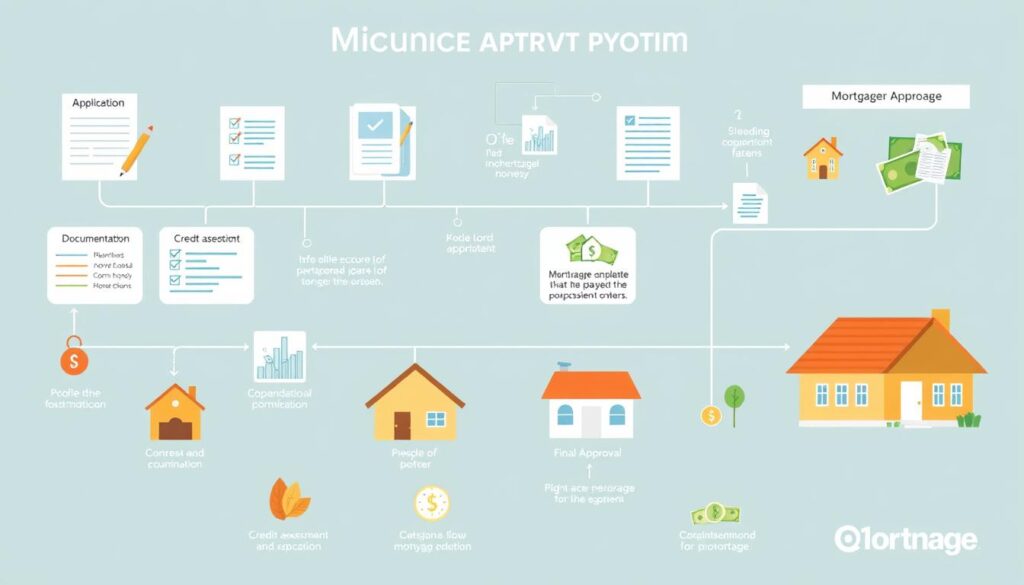The path to homeownership is embroiled with various financial assessments, chief among them being the underwriting process. At its core, this intricate process is the bedrock on which mortgage approval is built, scrutinizing every dimension of a potential borrower’s financial soundness. We take on the crucial task of conducting a comprehensive risk assessment, delving deep into applicants’ credit history, gauging their income against debts, and confirming the property’s value that they aim to finance.
Our endeavor in the underwriting process encompasses far more than a cursory glance at numbers. We meticulously verify applicants’ identities, pin down financial stability, and cross-examine the home’s worth — all to cement the promise of a sound investment for lenders. The duration in which we engage in this premium calculation and risk analysis can span a few days to several weeks, contingent upon the intricacy of the applicant’s financial profile and our operational dexterity.
Key Takeaways
- The underwriting process lays the groundwork for informed mortgage approval decisions.
- Understanding the applicant’s financial profile is pivotal to risk assessment.
- Accuracy in valuation is essential for precise premium calculation.
- Operational efficiency can significantly affect turnaround times in the underwriting process.
- Both manual and automated systems are used to ensure a thorough scrutiny.
- Identity verification and financial stability are crucial components evaluated by underwriters.
The Role of Underwriting in Mortgage Approval
Underwriting forms the backbone of the mortgage approval process, combining meticulous review and analysis of the applicant’s financial health. By adhering to strict underwriting guidelines and eligibility criteria, underwriters ensure the financial stability of the banking system and compliance with wider economic policies.
Defining the Underwriting Process
The underwriting process involves a detailed credit evaluation of potential borrowers to determine their ability to repay the loan. It assesses various factors including income, assets, and credit history, aligning with broader policy issuance standards. This fundamental review protects the lender from potential losses, promoting a stable lending environment.
Key Responsibilities of Mortgage Underwriters
Central to the role of mortgage underwriters is setting standards that applicants must meet to be considered for a loan. These standards are meticulously crafted, evolving from comprehensive credit evaluations and risk assessments to form robust underwriting guidelines. The primary aim is to minimize financial risks while making homeownership accessible to eligible applicants.
Assessing Credit History and Risk
The credit history and risk assessment are critical in determining if the applicants meet the eligibility criteria set forth. This process involves in-depth reviews of credit scores, debt-to-income ratios, and overall financial behavior, forming a cornerstone of the policy issuance.
Engaging in these practices not only secures the lender’s assets but also ensures that loans are granted to those who are most capable of fulfilling financial obligations, benefiting the entire banking ecosystem.
Delving into the Underwriting Guidelines and Criteria
At the core of mortgage underwriting lies the rigorous adherence to underwriting guidelines. These criteria not only ensure the financial viability of the loans but also uphold strict compliance standards that protect both the lender and the economy. Understanding and implementing these guidelines correctly is crucial for maintaining the stability of the financial system.
Actuarial analysis plays a pivotal role in this process by evaluating the risk associated with loan applicants. These evaluations help in setting fair, balanced premiums for mortgage insurance, which is a safety net against defaults. Additionally, automated decisioning systems have become integral in streamlining the underwriting process, reducing errors, and improving the efficiency of making lending decisions.
| Component | Description | Impact on Underwriting |
|---|---|---|
| Underwriting Guidelines | Criteria set by entities like Fannie Mae and Freddie Mac | Ensures loans meet national standards for quality and risk |
| Actuarial Analysis | Statistical assessment of risk in loan portfolios | Helps in determining appropriate premiums for mortgage insurance |
| Automated Decisioning | Use of AI and ML to make lending decisions | Increases precision and speed of loan approvals |
| Compliance | Adherence to legal and regulatory standards | Prevents legal repercussions and assures investor confidence |
In today’s lending landscape, keeping up with evolving underwriting guidelines and the sophisticated tools that support them, such as automated decisioning, is essential. It ensures not only the expedience but also the integrity of the mortgage approval process. By upholding stringent compliance and leveraging in-depth actuarial analysis, we can safeguard the interests of all stakeholders in the lending ecosystem.
The Underwriting Process: From Application to Decision
Embarking on the journey of homeownership or property investment invariably involves the meticulous and crucial underwriting process. This multi-step procedure assesses eligibility criteria, determines appraisal values, and culminates in the comprehensive policy issuance. Our goal is to demystify each stage, ensuring clients are well-prepared and confident throughout their application.
Initial Application and Preapproval Phase
The first step in securing a mortgage begins with the initial application, where potential borrowers present their financial standing and personal details. This phase involves a critical review of eligibility criteria to estimate a preliminary loan amount the client might expect, setting the groundwork for further examination.
Document Collection and Verification
Following a tentative preapproval, we delve deeper into verification. By gathering essential documents such as W-2s, pay stubs, and bank statements, our team conducts a thorough verification of income, assets, and employment history. This rigorous scrutiny is vital to ascertain the applicant’s repayment capacity and overall financial health.
Appraisal, Title Search, and Other Assessments
An imperative component of the underwriting process is the appraisal of the property. This evaluation ensures the requested loan amount is in alignment with the property’s market value. As part of this comprehensive examination, we also conduct title searches to uncover any legal claims that might affect ownership rights. The combined findings from these assessments play a pivotal role in the final mortgage decision-making process.
Successfully navigating these stages leads to the finalization of the loan through policy issuance, where conditions are established for a clear to close status. It’s a structured path designed to protect both the lender and borrower by ensuring all facets of the loan are thoroughly evaluated and compliant with regulatory standards.

In summary, our professional commitment during the underwriting process ensures that each client is met with transparency, thoroughness, and the dedicated expertise required for making informed decisions about their property financing options.
The Significance of Credit Evaluation in Underwriting
As we delve deeper into the underwriting process, we recognize the pivotal role of credit evaluation. This step is crucial in determining not just the viability of a mortgage approval, but also in shaping the borrower’s financial profile. By assessing credit history, underwriters ensure that the risk assessment is thorough and reflective of true credit behavior.
The examination of an individual’s credit history goes beyond basic numeric scores. It involves a detailed review of payment history, credit duration, types of credit, and usage rates. These factors collectively contribute to evaluating the creditworthiness that forms the cornerstone of lending decisions.
- Credit History: Essential in predicting future financial behavior
- Risk Assessment: Helps in determining the likelihood of consistent repayment
- Mortgage Approval: Directly influenced by the perceived risk and reliability of the borrower
- Financial Profile: Shapes the overall terms of the loan, including interest rates and repayment terms
Let’s consider the impact of a solid credit history. Often, a robust credit history leads to preferential lending terms. It indicates reliability and predicts a lower risk of default, which in turn, can considerably enhance the odds of favorable mortgage approval.
A clear understanding of one’s credit history and financial profile can empower borrowers to negotiate better terms and recognize the importance of maintaining credit health. It is evident that both lenders and borrowers benefit from comprehensive and careful credit evaluation during the underwriting process.
Risk Assessment and Its Impact on Loan Approval
In our ongoing commitment to enhance the integrity of our lending process, understanding the various facets of risk assessment is paramount. These assessments are essential components of underwriting, significantly influencing premium calculation, ensuring financial stability, and setting clear eligibility criteria within the realms of effective risk management.
Evaluating Loan-to-Value (LTV) Ratios
The Loan-to-Value ratio is a critical metric in determining how much risk is acceptably associated with a particular loan. A lower LTV ratio generally represents reduced risk, which is favorable for securing competitive interest rates. It reflects the amount of the loan compared to the appraised property value, impacting the assessment of loan eligibility.
Analyzing Debt-to-Income (DTI) Ratios and Financial Health
Our analysis of Debt-to-Income ratios helps us understand a borrower’s ability to manage monthly payments against their income. By maintaining stringent checks on this ratio, we uphold our responsibility towards promoting financial stability and ensuring that borrowers are not overextended in their credit responsibilities.
Understanding Manual vs. Automated Decisioning Systems
The choice between manual and automated decisioning systems plays a significant role in determining the outcome of a loan application. Manual systems allow for a more flexible approach, particularly valuable in assessing non-traditional income streams or complex financial scenarios. Automated systems, on the other hand, provide speed and consistency in decisions, guided by predefined eligibility criteria and risk parameters.
| Assessment Criteria | Manual Decisioning | Automated Decisioning |
|---|---|---|
| Flexibility in Evaluation | High | Low |
| Speed of Processing | Variable | Fast |
| Consistency | Variable | High |
| Approach to Non-traditional Incomes | Customized | Standardized |
Premium Calculation for Mortgage Insurance
In our endeavors to ensure financial stability and effective risk management, the focus frequently rests on the precision of premium calculation for mortgage insurance. This process not only protects lenders but aligns closely with responsible financial assessment principles.
The calculus involved in determining these premiums integrates multiple risk factors. These include the Loan-to-Value (LTV) ratio, creditworthiness of the borrower, and Debt-to-Income (DTI) ratios. Our approach emphasizes a tailored risk management strategy, ensuring that mortgage insurance rates are congruent with the assessed risks.
- Risk Analysis: Integral in setting premiums based on potential likelihood of default.
- Financial Assessment: Ensures the stability and credibility of borrowers.
- Regulatory Compliance: Adhering to standards to safeguard both lender and borrower interests.
By integrating these elements, mortgage insurance premium calculation serves as a cornerstone of sound financial practices within real estate financing. Below is a simplified outline of how these components are factored into the premium setting process:
| Component | Role in Premium Setting |
|---|---|
| LTV Ratio | Indicates the percentage of the loan amount comparative to the property value, influencing risk level. |
| Creditworthiness | Assessment of borrower’s financial history and ability to repay the loan. |
| DTI Ratio | Measures borrower’s monthly debt load against their income, assessing financial burden. |
Meticulous financial assessment and robust risk management strategies ultimately benefit both the lender and the borrower, ensuring that the premiums are a true reflection of risk while promoting long-term sustainability in the housing market.

Ensuring Compliance and Fraud Detection During Underwriting
In the meticulous world of underwriting, maintaining compliance and effectively managing risk are paramount, not only to meet regulatory requirements but also to enhance the integrity of financial transactions. Our vigilance in fraud detection plays a critical role in safeguarding the interests of all parties involved.
Regulatory Requirements for Underwriters
We adhere to a strict set of regulatory requirements designed to enforce compliance and mitigate risks. These guidelines ensure that each step of the underwriting process is conducted with the highest level of integrity and due diligence.
How Underwriters Identify and Prevent Fraud
The efforts to prevent fraud begin with a comprehensive evaluation of all documentation and data received. Utilizing advanced analytics, we scrutinize the origin of deposits, verify income sources, and confirm the authenticity of personal information.
| Check | Purpose | Method |
|---|---|---|
| Origin of Deposits | To verify the legitimacy of funds | Data matching and historical analysis |
| Income Verification | To assess financial stability | Review of employer documentation and tax returns |
| Personal Information Authenticity | To prevent identity theft | Biometric checks and cross-referencing public records |
Data Analytics in Modern Underwriting
In our ongoing endeavor to refine the underwriting process, we’ve turned to Data Analytics to augment our capabilities in Risk Management and operational efficiency. Data analytics in Modern Underwriting not only boosts our ability to assess the Financial Profile of applicants but also enhances the precision of detecting and managing inherent risks.
Data Analytics serves as the backbone of modernized underwriting operations. By integrating sophisticated mathematical models and statistical analysis, it supports our goal of precisely forecasting the likelihood of loan repayment and identifying irregular patterns that may indicate fraudulent activities.
Utilizing advanced analytics, we efficiently process vast swathes of applicant data, which significantly expedites the decision-making process. This approach not only contributes to quicker turnaround times but also helps in making informed decisions that align with contemporary risk management practices.
| Feature | Impact on Modern Underwriting |
|---|---|
| Enhanced Risk Analysis | Enables more accurate identification and classification of potential risks. |
| Precision in Financial Profiling | Improves the accuracy of assessing applicant’s financial stability and predictability of loan repayment. |
| Fraud Detection | Advanced patterns recognition helps in early detection of discrepancies or fraudulent claims. |
| Regulatory Compliance Verification | Data analytics tools ensure compliance with regulations by systematic examination of data against standardized criteria. |
This integrated approach to modern underwriting, powered by Data Analytics, is redefining how we engage with and comprehend the nuanced aspects of financial profiles and risk management strategies, significantly impacting the landscape of the mortgage lending sector.
Conclusion
The underwriting process stands as a critical checkpoint in the journey toward mortgage approval and the fulfillment of homeownership dreams. As we’ve explored in this article, this multifaceted process operates as the backbone for ensuring that lenders can provide a solid foundation for home financing, while equipping aspiring homeowners with the keys to a future built on financial stability. The adherence to rigorous guidelines during the underwriting process signifies a commitment to precision and care, essential in aligning borrowers with suitable mortgage options that accommodate their specific circumstances.
With the relentless march of technology, the realm of home financing continues to be reshaped, introducing cutting-edge tools like data analytics and innovative automated decisioning systems. These advancements aid the underwriting process by streamlining operations, thereby enhancing both accuracy in risk assessment and efficiency in policy compliance and premium calculation. Yet, despite such evolution, the core objective of safeguarding both the lender’s and borrower’s interests remains steadfast.
Our commitment lies in delivering exceptional home financing guidance, ensuring that our clients are well-informed and prepared as they embark on this significant venture. The intricacies of the underwriting process highlight the crucial steps taken to safeguard all parties involved, emphasizing that careful scrutiny today translates to lasting security and satisfaction tomorrow. As stewards of this intricate journey, we pledge to continue providing clarity and support to our clients, every step of the way toward achieving successful homeownership.







